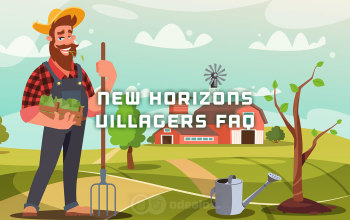|
There are 8 villager personalities in total, 4 male and 4 female:
Female:
- Sisterly – The rarest personality in the game (there are only 23 Sisterly villagers currently). Sisterly types are among the most supportive and caring of villagers but they can be a bit patronizing sometimes (like older sisters, hence the Japanese name,アネキ; Big Sister, of this type) which can make them appear somewhat rude and blunt on occasion. Befriended Sisterly villagers are almost guaranteed to give you medicine if you are stung by bees, so it is a great idea to have at least one of them on your island.
- Peppy – These villagers are like cheerleaders, essentially. They love cheering and are overly excitable which makes them act before they think, sometimes (and quickly apologize for their actions, even if they didn't do anything wrong). The word "energetic" is often the first that comes into mind when interacting with Peppy villagers. Currently, there are 65 Peppy female villagers in Animal Crossing: New Horizons.
- Normal – The most common female villager personality; as of New Horizons, there are 71 Normal Villagers. Normal Villagers try to keep a down-to-earth mindset, which makes them have neutral opinions on some things; they don't get excited by anything, but they also don't disapprove of things. Their behavior towards the player is very kind and friendly, most of the time, as is their stance towards other villagers (however, they don't get along with Cranky villagers because of their arrogant behavior). If you like mother-like figures, Normal villagers will fit on your island perfectly.
- Snooty – These villagers like to emphasize how well-behaved, posh, and mature they are, which sometimes makes them appear rude, and, well... snooty, towards the player and other villagers. Their stance towards people and their "high standards" result in them being overly sarcastic. Moreover, they tend to be narcissistic and think mostly (or only) about themselves, their looks, their clothing, and their overall appearance. Snooty Villagers are often like those "popular" kids in every school; they are artificially kind as long as they stay in the center of attention. They struggle to socialize with villagers who don't admire them and with ones who don't care about their personal appearance.
Male:
- Smug – These villagers tend to behave very friendly towards the player and other villagers, but they also like to emphasize how cool they are in the process (which can make them appear somewhat conceited at times). Smug villagers are likely to flirt with the player, for example by being overly gentleman-like and a bit too kind. Despite the fact that they tend to get along with other villagers rather well, they find it hard to tolerate the companionship on Sisterly, Jock, and Cranky villagers. As of Animal Crossing: New Horizons, there are 36 Smug Villagers available.
- Jock – The most common personality overall, with 76 villagers. Jock persons are often described as sports enthusiasts who prefer muscles over brains (high school football player stereotype fits the term rather well). In Animal Crossing, Jock villagers are mainly interested in physical fitness, sports competitions, and exercises. This makes them dislike Lazy and Snooty villagers who don't like physical effort. Jock villagers often brag about their physical shape and capabilities, but also tend to behave like bigger brothers towards the player (which is not always a good thing, unless one likes a bit of bullying mixed up with pep talks and somewhat primitive encouragements).
- Lazy – As the name suggests, lazy villagers are the exact opposite of the Jock ones. What they like the most is food (a large amount of it) and twiddling their thumbs. Even thought of physical exercises or effort makes them flinch; no wonder that Jock villagers tend to dislike them. Lazy Villagers' laid-back and relaxed lifestyle makes them get along with Peppy and Normal villagers rather well but gets on the Jock, Snooty, and Pepy ones' nerves. When befriended, Lazy Villagers like to tell the player various made-up stories. As of right now, there are 74 Lazy Villagers in Animal Crossing: New Horizons, which makes them the second-most common type.
- Cranky – These villagers are somewhat socially-awkward and a bit hot-headed. Moreover, they tend to get irritated and annoyed surprisingly easily which makes interacting with them similar to playing with a bomb that can explode at any time. Cranky villagers appear rude and withdrawn at first glance, but they eventually open up, after the player gains enough of their trust, and start to behave much more friendly and even protective towards the player. Cranky villagers don't get along with Sisterly, Smug, and Peppy villagers, but easily befriend Snooty and Jock types. Currently, there are 63 Cranky Villagers in the Animal Crossing series.
|




